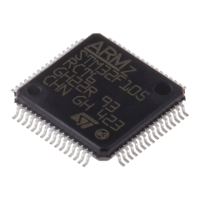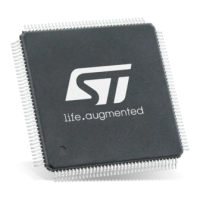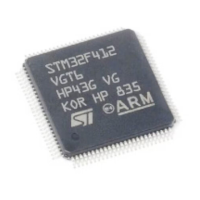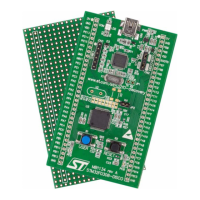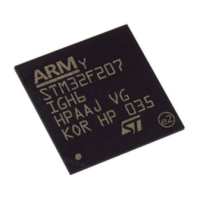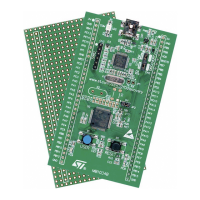Inter-integrated circuit (I
2
C) interface RM0008
754/1096 Doc ID 13902 Rev 12
Bit 3 ADD10: 10-bit header sent (Master mode)
0: No ADD10 event occurred.
1: Master has sent first address byte (header).
–Set by hardware when the master has sent the first byte in 10-bit address mode.
–Cleared by software reading the SR1 register followed by a write in the DR register of the
second address byte, or by hardware when PE=0.
Note: ADD10 bit is not set after a NACK reception
Bit 2 BTF: Byte transfer finished
0: Data byte transfer not done
1: Data byte transfer succeeded
–Set by hardware when NOSTRETCH=0 and:
–In reception when a new byte is received (including ACK pulse) and DR has not been
read yet (RxNE=1).
–In transmission when a new byte should be sent and DR has not been written yet
(TxE=1).
–Cleared by software reading SR1 followed by either a read or write in the DR register or
by hardware after a start or a stop condition in transmission or when PE=0.
Note: The BTF bit is not set after a NACK reception
The BTF bit is not set if next byte to be transmitted is the PEC (TRA=1 in I2C_SR2
register and PEC=1 in I2C_CR1 register)
Bit 1 ADDR: Address sent (master mode)/matched (slave mode)
This bit is cleared by software reading SR1 register followed reading SR2, or by hardware
when PE=0.
Address matched (Slave)
0: Address mismatched or not received.
1: Received address matched.
–Set by hardware as soon as the received slave address matched with the OAR registers
content or a general call or a SMBus Device Default Address or SMBus Host or SMBus
Alert is recognized. (when enabled depending on configuration).
Address sent (Master)
0: No end of address transmission
1: End of address transmission
–For 10-bit addressing, the bit is set after the ACK of the 2nd byte.
–For 7-bit addressing, the bit is set after the ACK of the byte.
Note: ADDR is not set after a NACK reception
Bit 0 SB: Start bit (Master mode)
0: No Start condition
1: Start condition generated.
–Set when a Start condition generated.
–Cleared by software by reading the SR1 register followed by writing the DR register, or by
hardware when PE=0

